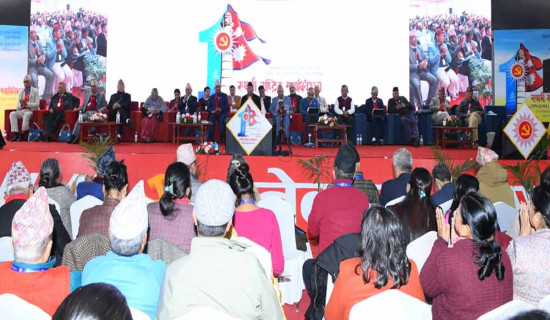- Monday, 15 December 2025
Religious Harmony Key To Peace
Nepal is a multi-ethnic, multi-cultural, and multi-religious country where people of various religions have demonstrated tolerance and a cohesive attitude with respect for individuals of diverse beliefs. However, sporadic incidents occasionally threaten to destroy this conviction. One such incident that took place in the eastern town of Dharan in Koshi province lately gained a lot of traction nationwide.
In Dharan, a group of persons reportedly affiliated with a non-Hindu religious organisation, slaughtered an ox and ate its meat last week. As if eating ox meat wasn't enough, some members of this group posted videos of ox meat on social media, provoking the ire of Hindu groups. The planned march of pro-Hindu organisations in Dharan was averted only after the district authorities sprang to action and enforced a curfew the day before the march. It certainly prevented the possibility of violence in the town, where pro-Hindu protesters could have clashed with those who ate ox meat and those who supported such an act. To defuse the escalating tensions, Prime Minister Pushpa Kamal Dahal Prachanda and Nepali Congress president Sher Bahadur Deuba issued statements urging all parties involved to maintain religious harmony by showing their goodwill to interfaith beliefs.
Sacrilegious act
The incident did hint at how fragile social and religious harmony has become in Nepali culture, which is acclaimed for its tolerant nature, if and when some forces attempt to cross the barrier with a flagrant intent that threatened to stoke communal hatred. A substantial population affiliated to a certain faith in the town has frequently come up to undermine Hindu sensitivities by asking authorities that they be allowed to consume ox or cow meat, which has exacerbated the situation for a huge number of Hindus who regard oxen and cows as their sacred animals. Despite being a secular country, Nepal has a law that basically outlaws the slaughter of these creatures under any circumstances. Even injuring these creatures is punishable.
So, for predominantly Hindus, slaughtering an ox is a sacrilegious act, which often leads to hordes of Hindus taking to the streets and demanding punishment for the perpetrators. The Rastriya Prajatantra Party, a pro-Hindu and pro-royalist party, asked the government to arrest those who slaughtered the ox and ate its meat in Dharan. Meanwhile, many have chastised Dharan Mayor Harka Sampang Rai for failing to intervene in time to prevent the culprits from slaughtering the creature. Though he was forced to make his statement imploring the people to maintain harmony after the situation threatened to turn violent, he was originally attacked for ignoring the culprit.
Mayor Rai, who some claim is a non-Hindu, might have stopped the perpetrators in indulging the slaughter, for which he faced widespread criticism. In recent months Rai has been accused of making blunders on certain critical issues of public importance. In addition to failing to maintain social cohesion in his town, which is home to people of all faiths, he is accused of interfering with private property problems. The current verbal sparring between Mayor Rai and a social media influencer, Bhim Prasad Upadhyay, has also fueled the fire ignited after the ox slaughter. Upadhyay, who claims to be a Hindu but says he respects the beliefs of others, has blasted the mayor for encouraging the offenders and the government for failing to take action against them.
Pro-Hindu organisations and their members are angry over the federal and provincial governments, which, for them, have done insufficient to uphold the law that prohibits offenders from slaughtering Hindus' ‘sacred' creatures. If there is a law prohibiting such a slaughter, then the government authorities must act against the offenders in accordance with the law, according to Gyanendra Shahi, the RPP's firebrand leader. However, many believe that the administration could not exacerbate the situation, thus it remained silent in order not to inflame community sensitivities.
The Dharan episode demonstrated that the fabric of social and religious harmony has become a highly delicate issue ever since the country became a secular society, where pro-Hindu parties have become increasingly sensitive to anything that they believe challenges Hindu faith or values. Nowadays, if any religious group unleashes violence on adherents of other religious faiths, it will completely disrupt the overall harmony in a mostly tolerant Nepali society, threatening to ignite a vicious circle of violence across the country. Our authorities, political and social leaders, members of civil society, and intelligentsia must be conscious that nothing of the sort will occur.
Meanwhile, our officials tend to be ignorant of the impact that social media platforms can generate these days. Many believe that the Dharan episode, in which possible religious conflict was avoided, is also a byproduct of social media platforms where people of different faiths spat poison against each other through their caustic comments. Whenever such unwanted comments threaten to escalate the crisis such as the one in Dharan, government officials must step in to monitor social media and take effective measures to so that such a social media trend cease as soon as possible in order to avoid further escalation of tensions in and around the affected areas.
Respect for diversity
We have plenty of instances in nearby India, where authorities are quick to monitor and prevent problems from worsening by turning off the internet in the afflicted district or region. If our officials had acted sooner, the situation in Dharan and its environs would not have deteriorated to the level where the authorities had to impose a curfew. Returning to our main point, actions that subvert others’ beliefs, faith and values can weaken the social links that hold a varied society together. This gives rise to social and religious fragmentation and conflict, making it difficult to negotiate collective concerns and cooperate towards common goals.
Religious peace is crucial for creating a cohesive and successful society in a diverse nation like Nepal, where people come from numerous ethnicities, cultures, and religions. It takes a plethora of efforts from the government, civil society members and interfaith leaders to foster interfaith discussion and respect for diversity that can lead to peace among the adherents of different religious beliefs.
(Upadhyay is former managing editor of this daily.)
















